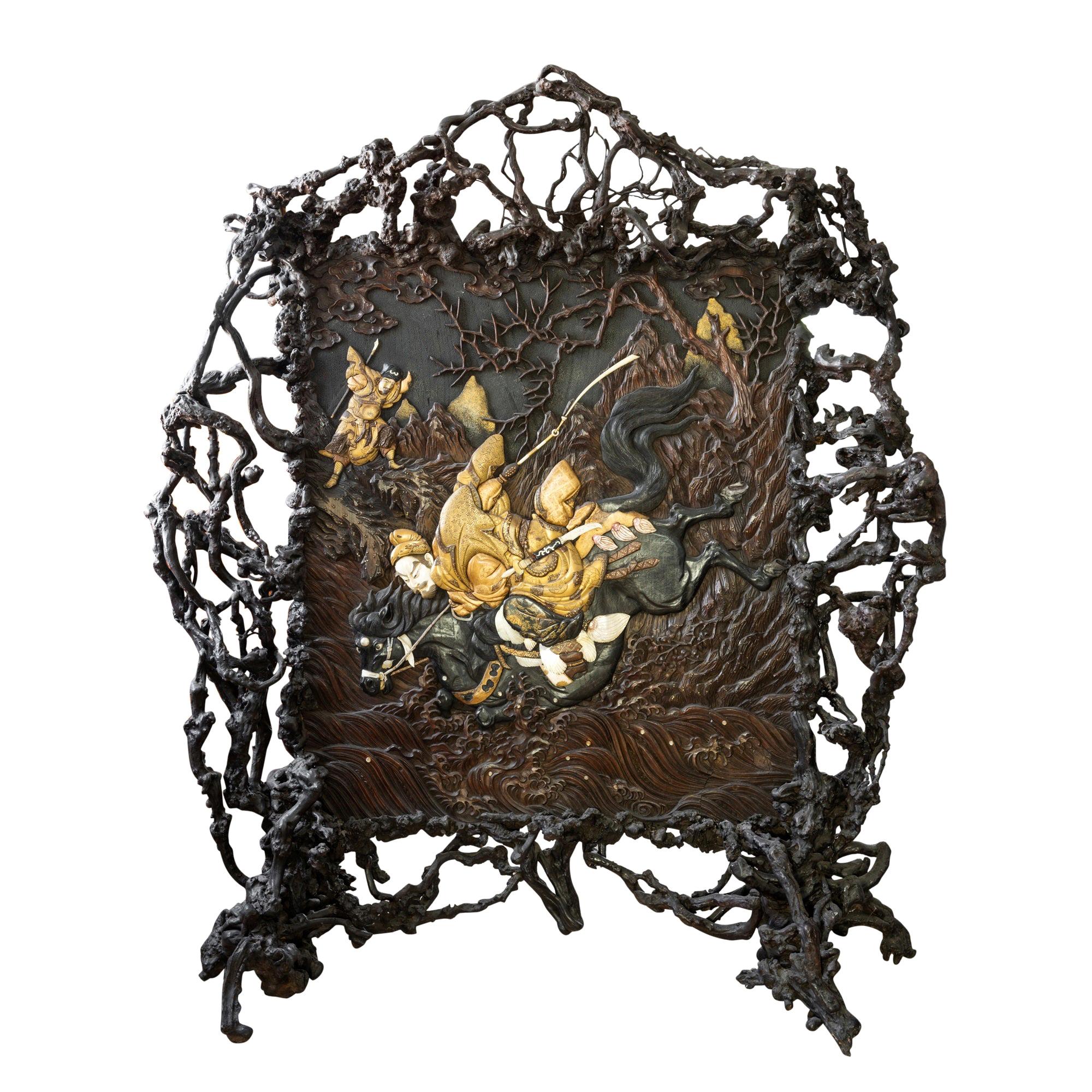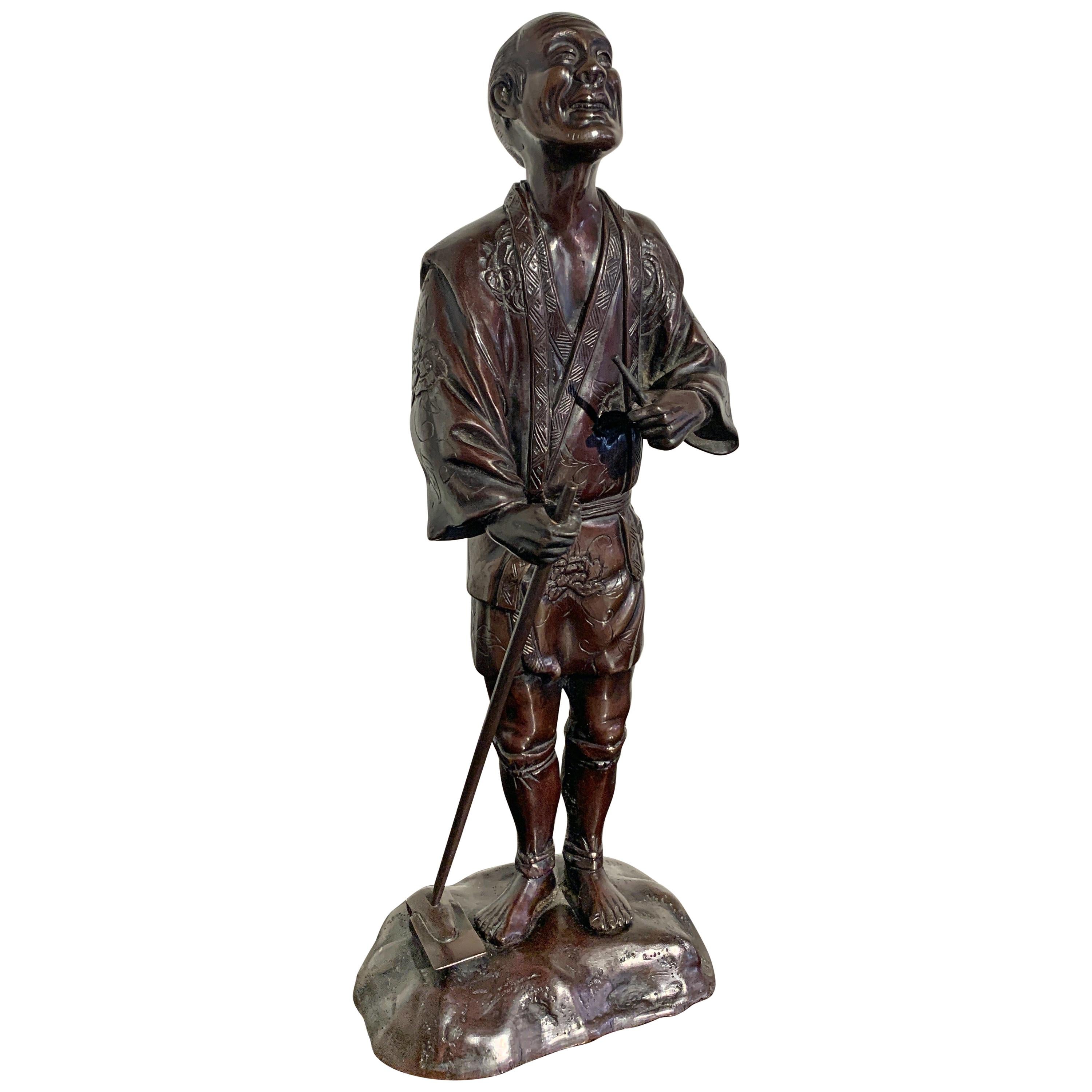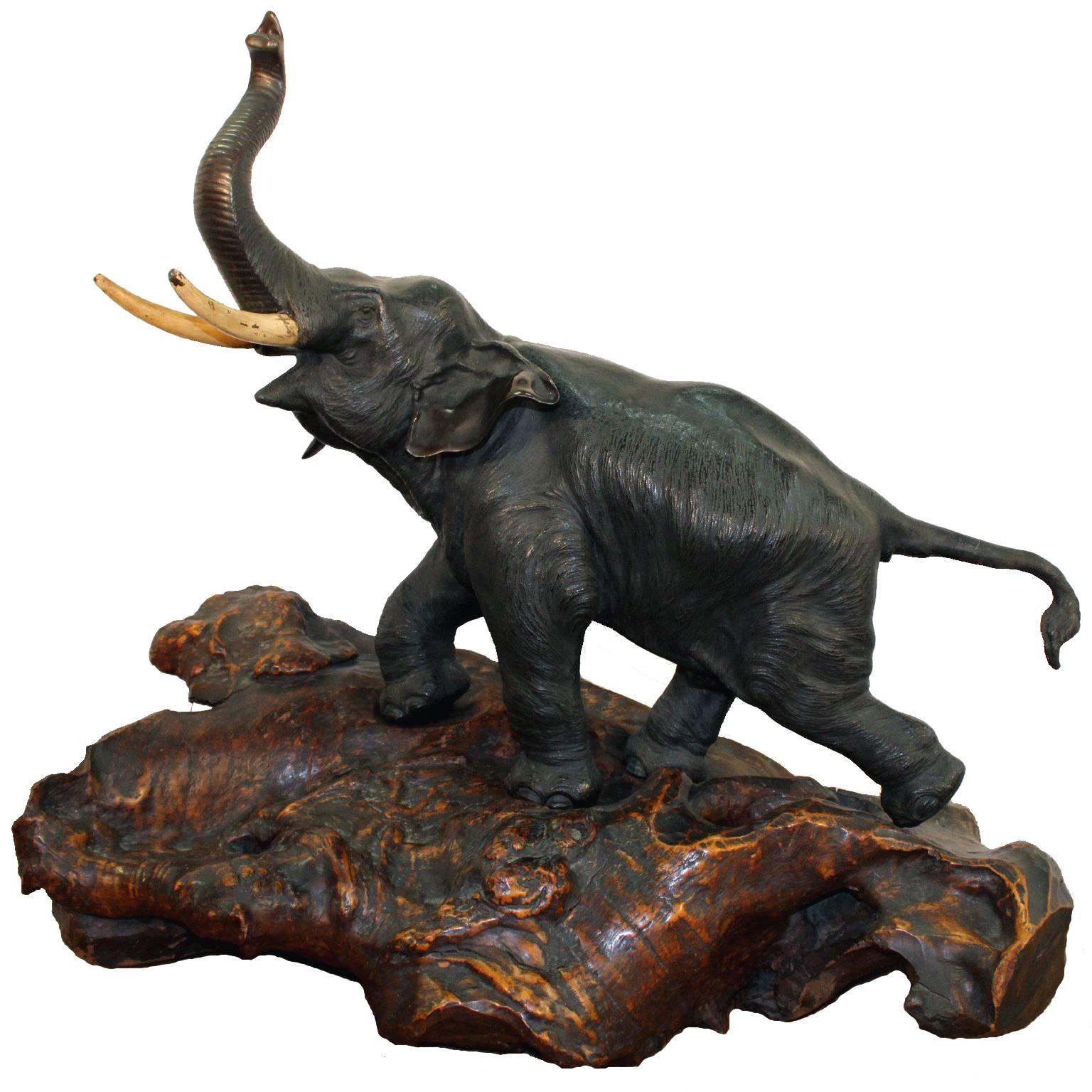Items Similar to Japanese Gilt Wood Fukukenjaku Kannon, Meiji Period or Earlier, Japan
Want more images or videos?
Request additional images or videos from the seller
1 of 16
Japanese Gilt Wood Fukukenjaku Kannon, Meiji Period or Earlier, Japan
About the Item
An attractive and esoteric Japanese carved and gilt wood figure of Fukukenjaku Kannon, Amoghapasa, Meiji period or earlier, Japan.
Fukukenjaku Kannon is portrayed in an usual six armed form, with the primary hand raised at heart level and performing anjali mudra, the gesture of devotion, one pair of secondary arms are outstretched, hands closed to grasp attributes which are now missing (one of which would have been a lasso), and another pair of arms is raised with hands outstretched and palms facing up.
He is seated in full lotus position with the soles of the feet upturned. Fukukenjaku Kannon is dressed in beautifully draped heavy robes covering his robust body, leaving the chest exposed.
His face is solemn and serene. An urna marks his forehead, set between his almond shaped and downcast eyes.
The sculpture has been re-gilt, possibly several times. As such, it is difficult to ascertain the true age of this piece. We are very conservatively dating it as Meiji, though it could be much older, Edo Period, or even Muromachi - Momoyama. The loosely woven fabric under the lacquer, visible on the underside of the sculpture, would suggest an earlier dating.
This figure is known as Fukukenjaku Kannon in Japan. The name is translated from the Sanskrit Amoghapasha, meaning Never Empty Lasso. The lasso is a metaphor for the compassion of Amoghapasha. Never empty, and never failing, the lasso (compassion) is large enough to encompass all sentient beings, drawing them out of suffering, into enlightenment.
- Dimensions:Height: 10.5 in (26.67 cm)Width: 11 in (27.94 cm)Depth: 7 in (17.78 cm)
- Style:Meiji (Of the Period)
- Materials and Techniques:
- Place of Origin:
- Period:1900-1909
- Date of Manufacture:1900 or Earlier
- Condition:Repaired: Possible repairs to the arms. The figure re-gilt. Refinished. Wear consistent with age and use. Minor losses. Minor structural damages. Minor fading. The figure has been re-gilt at some point. The arms possibly repaired. Missing the attributes. Missing the crown. Scattered cracks and losses to the gilt lacquer. One large loss to the lacquer at the shoulder. See photos.
- Seller Location:Austin, TX
- Reference Number:1stDibs: LU894731115002
About the Seller
5.0
Platinum Seller
These expertly vetted sellers are 1stDibs' most experienced sellers and are rated highest by our customers.
Established in 2001
1stDibs seller since 2010
305 sales on 1stDibs
Typical response time: 1 hour
- ShippingRetrieving quote...Ships From: Austin, TX
- Return PolicyA return for this item may be initiated within 7 days of delivery.
More From This SellerView All
- Pair of Japanese Gilt Bronze Komainu by Ishikawa Komei, Meiji PeriodLocated in Austin, TXA striking pair of Japanese gilt bronze komainu by the renowned Japanese sculptor, Ishikawa Komei (1852-1913), Meiji period, Japan. The pair well cast, and robustly modeled. They ar...Category
Antique Late 19th Century Japanese Meiji Sculptures and Carvings
MaterialsBronze
- Japanese Tokyo School Bronze Okimono of a Farmer, Meiji PeriodLocated in Austin, TXA very fine and detailed Tokyo School cast bronze okimono (decorative sculpture) of a smiling farmer, Meiji period, late 19th century, Japan. The e...Category
Antique Late 19th Century Japanese Meiji Sculptures and Carvings
MaterialsBronze
- Japanese Miyao Style Gilt Bronze Samurai Archer, Meiji Period, JapanBy Eisuke Miyao 1Located in Austin, TXA spectacular Japanese cast, carved, and parcel gilt bronze sculpture, okimono, of a kneeling samurai archer, signed Kiyotsugu (died 1894), Meiji ...Category
Antique Late 19th Century Japanese Meiji Sculptures and Carvings
MaterialsBronze
- Pair of Japanese Cast Bronze Figures of Niō, Meiji Period, Late 19th CenturyLocated in Austin, TXA well cast pair of Japanese mixed metal okimono figures of Buddhist guardians, known as Nio or Dharmapala, protectors of Buddhist faith, Meiji Period, Japan. The smiling bronze g...Category
Antique Late 19th Century Japanese Meiji Sculptures and Carvings
MaterialsBronze
- Pair of Japanese Gilt Wood Komainu, Guardian Lions, Early 20th Century, JapanLocated in Austin, TXA charming and mischievous pair of Japanese carved, gilt and painted komainu, often mistaken for foo dogs or foo lions, Showa Period, 1920's, Japan. The two komainu, or guardian lions, are portrayed seated upon their haunches, heads slightly turned. The two beasts are well carved, with wonderful musculature, flowing manes, and bushy tails. Their faces a mix of ferocious and comical. The eyes of reverse painted glass with gilt highlights. One is a true komainu, (lion-dog), with a horn on its head, and its mouth closed. The other is a shishi, (lion), with its mouth open, and no horn. The komainu sports a mane and tail pigmented blue with gilt highlights. The shishi sports a mane and tail pigmented green with gilt highlights. Both figures richly gilt in gold lacquer. Komainu are protective beings, similar to foo lions or foo dogs...Category
Vintage 1920s Japanese Showa Sculptures and Carvings
MaterialsGlass, Cypress, Wood
- Japanese Bronze Okimono of a Carp, Taisho Period, Early 20th Century, JapanLocated in Austin, TXAn elegant Japanese cast bronze okimono of a swimming carp, Taisho Period (1912 - 1926), early 20th century, Japan. The graceful fish portrayed realistically in motion, as if swimmi...Category
Vintage 1920s Japanese Taisho Sculptures and Carvings
MaterialsBronze
You May Also Like
- Japanese Meiji Period Carved Wood Okimono Man with RabbitsLocated in Newark, EnglandThe charming figure, carved from a single piece of wood is exceptionally carved showing the male figure with humorous expression holding two Rabbits one by the ears and the second under his arm. A third Rabbit stands at the feet of the male looking up, each rabbit with a different expression. The male figure is wearing traditional Japanese attire with his hair tied back stood upon a naturalistic base. The figure dates to the Meiji Period (1868-1912) circa 1900. Notes The Rabbit is one of the 12 animals to feature in the Japanese Zodiac signs which follows the Chinese astrological system along with the Rat, Ox, Tiger, Rabbit, Dragon, Snake, Horse, Goat, Monkey, Rooster, Dog, Pig. Such division is connected with the Jupiter cycle around the Sun, which lasts about 12 years. As 2023 is the year of the Rabbit...Category
Antique Early 1900s Japanese Meiji Sculptures and Carvings
MaterialsWood
- Japanese Gilt Seated Kannon Figure, circa 1850Located in Chicago, ILIntricately carved and finished with gilt black lacquer, this seated figure depicts the bodhisattva Guanyin, known in Japanese Buddhism as Kannon. Described as the "Buddha of Infinite Compassion," Kannon is the embodiment of mercy and makes himself available to all who call upon him with all their mind. Kannon is depicted here seated in diamond position upon a double lotus plinth, set above a stepped base. He is dressed in gracefully draped robes and wears a tall crown bearing a minuscule figure of Amida, the Buddha of Infinite Light. He has a serene expression of calm and holds his right hand in the abhaya mudra, a gesture of comfort, blessing, and protection. Backed by a magnificent leaf-form nimbus, this Kannon figure...Category
Antique Mid-19th Century Japanese Edo Sculptures and Carvings
MaterialsWood, Lacquer
- Japanese Lacquer, Bone and "Root" Wood Screen Meiji PeriodLocated in West Palm Beach, FLA Japanese lacquer, bone and "Root" wood screen Meiji period, late 19th century of rectangular form, inlaid and applied in relief with finely carved bone with large leafy peony spr...Category
Antique 19th Century Abstract Sculptures
MaterialsLacquer
- Japanese Meiji Period Bronze Elephant Sculpture on Burlwood BaseLocated in New York, NYA Japanese Meiji period bronze elephant sculpture on its original burl-wood base. Old repair to the tail; some paint chips to bronze trunk; unsigned.Category
Antique 1880s Japanese Meiji Animal Sculptures
MaterialsBronze
- Two Rare Japanese Izumo Clay Dolls of Emperor and Tenjin, Meiji PeriodLocated in Ottawa, OntarioTwo rare Japanese Izumo clay dolls of Emperor and Tenjin, Nara Prefecture, Meiji period. Material and simple execution impart a flavor of antiquity and great decorative power. Empero...Category
Antique Late 19th Century Japanese Meiji Sculptures and Carvings
MaterialsClay
- Meiji Period Carved Lion and TigerLocated in Pasadena, CAThis is an outstanding pair of Meiji Period carved hardwood figures of a ferocious lion and tiger. The carving is exceptional as is the bone detailing of the mouthes and teeth. The f...Category
Antique Late 19th Century Japanese Meiji Animal Sculptures
MaterialsBone, Hardwood
Recently Viewed
View AllMore Ways To Browse
Vintage & Antique Trash Cans and Wastebaskets
Banksy Save Or Delete
Meridienne Or Recamier
Collier Or 200grammes
Antique Or
Wood Figural
Japanese Fabric
Antique Wood Levels
Fabrics From Japan
Japanese Seat
Gilt Wood Sculpture
Wood Carving Set
Japanese Antique Marks
Palm Gilt
Large Gilt Sculpture
Dress Form Wood
Japanese Chest On Chest
Chests From Japan





